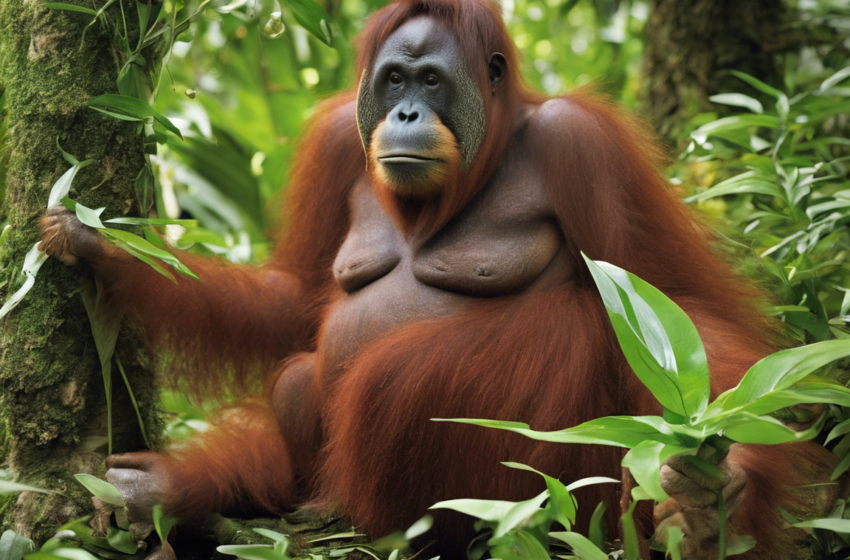Discover the Healing Power of Orangutan Medicinal Plants!

Orangutans, the magnificent great apes of the rainforests of Indonesia and Malaysia, have long been known for their intelligence, agility, and remarkable ability to use tools. Recent research has shed light on another fascinating aspect of orangutan behavior – their extensive knowledge of medicinal plants. These gentle giants have been observed using a variety of plants for self-medication, indicating a level of sophistication and understanding of their environment that is truly awe-inspiring.
The Relationship Between Orangutans and Medicinal Plants
Orangutans have been observed ingesting certain plants that have been found to have medicinal properties. These plants are believed to help the orangutans treat various ailments and maintain their health. Researchers have documented orangutans using these medicinal plants to alleviate gastrointestinal issues, fight infections, reduce inflammation, and even ease pain.
Examples of Medicinal Plants Used by Orangutans
1. Dracaena cantleyi
- This plant is used by orangutans to treat diarrhea. The leaves are chewed and the juices ingested, providing relief from stomach troubles.
2. Macaranga tanarius
- Orangutans have been observed using the leaves of this plant to create a poultice that is applied to wounds, showing antimicrobial properties.
3. Piper betle
- The leaves of this plant are chewed by orangutans to relieve pain. It is believed to have analgesic properties.
4. Leea guineensis
- Used by orangutans to reduce inflammation. The leaves of this plant are consumed to alleviate swelling and discomfort.
The Implications for Human Health
Studying the interaction between orangutans and medicinal plants not only provides valuable insights into animal behavior and ecology but also offers potential benefits for human health. Many traditional Indonesian medicinal practices are based on the use of plants that orangutans also consume, suggesting a shared knowledge of the healing properties of certain botanical species.
By examining the chemical composition of these plants and understanding how they affect orangutans, researchers hope to identify new natural remedies that could be used to develop pharmaceuticals for human use. This interdisciplinary approach, known as zoopharmacognosy, has the potential to unlock a treasure trove of bioactive compounds that could lead to the discovery of novel drugs and therapies.
Conservation and Protection of Orangutans
The exploration of orangutan medicinal plant use also underscores the importance of conservation efforts to protect these critically endangered primates. Deforestation, illegal poaching, and the illegal pet trade pose significant threats to orangutans and their habitats, jeopardizing not only the survival of these remarkable animals but also the preservation of valuable ethnobotanical knowledge.
By raising awareness of the intricate relationship between orangutans and medicinal plants, we can highlight the urgent need to conserve rainforests and biodiversity hotspots. Protecting orangutans and their habitats is not only essential for the survival of these iconic species but also crucial for maintaining the delicate balance of ecosystems and preserving the wealth of ethnopharmacological knowledge that they possess.
Frequently Asked Questions (FAQs) About Orangutans and Medicinal Plants
1. Do orangutans have a natural instinct for selecting medicinal plants?
Orangutans are believed to have an innate ability to identify and use medicinal plants based on trial and error, observation, and possibly even cultural transmission within their populations.
2. Are there any risks associated with orangutans using medicinal plants?
While orangutans have shown remarkable adaptability in using medicinal plants, there is also the potential for toxicity if certain plants are consumed in large quantities or used incorrectly.
3. How can the study of orangutan medicinal plant use benefit human health?
Understanding the medicinal properties of plants consumed by orangutans can lead to the discovery of new drugs, supplements, and treatments for various human health conditions based on ethnopharmacological knowledge.
4. What role do traditional healers and indigenous communities play in preserving orangutan medicinal plant knowledge?
Traditional healers and indigenous communities often have valuable insights into the uses of medicinal plants that orangutans also consume, contributing to the preservation of ethnobotanical knowledge.
5. How can individuals contribute to orangutan conservation efforts?
Supporting conservation organizations, promoting sustainable practices, and raising awareness about the importance of protecting orangutans and their habitats are crucial ways in which individuals can contribute to conservation efforts.